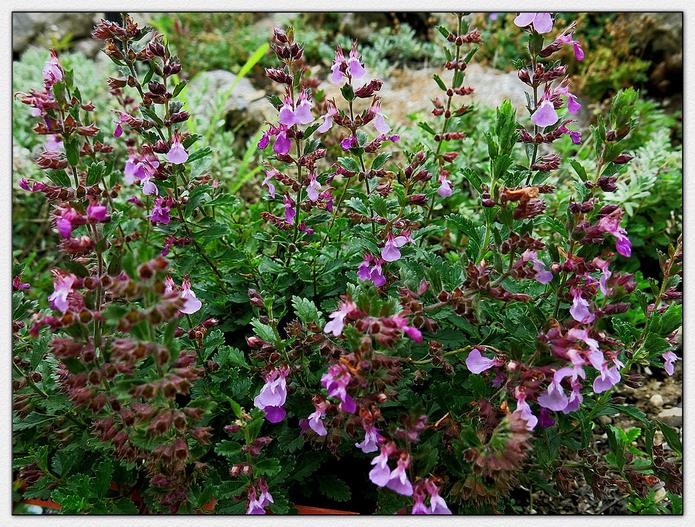Wall Germander
(Teucrium chamaedrys)
Wall Germander (Teucrium chamaedrys)
/
/

manuel m. v.
CC BY 2.0
Image By:
manuel m. v.
Recorded By:
Copyright:
CC BY 2.0
Copyright Notice:
Photo by: manuel m. v. | License Type: CC BY 2.0 | License URL: https://creativecommons.org/licenses/by/2.0/ | Uploader: M. Martin Vicente | Publisher: Flickr


































































































Estimated Native Range
Summary
Teucrium chamaedrys, commonly known as Wall Germander, is an evergreen perennial herb native to the Mediterranean region, including Europe and North Africa, and extending to the Middle East as far east as Iran. It thrives in open woodlands, rocky hillsides, and scrub areas, where it forms dense mats. Wall Germander typically grows 6–18 inches tall and is known for its glossy, dark green, scalloped opposite leaves that are 0.5–1.5 inches long. From late summer to early fall, it produces showy, tubular pink to purple flowers that grow in whorls from the leaf axils, attracting bees and butterflies.
Wall Germander is valued for its low maintenance, drought tolerance, and ornamental qualities, including its aromatic foliage and flowers. It is commonly used in rock gardens, as a ground cover, or for edging in herb gardens and borders. It prefers full sun but can tolerate part shade and requires well-drained soil. It is hardy in USDA Zones 5–10 and can be propagated by vegetative cuttings or division of clumps. While it has historical medicinal uses, it is primarily grown for its aesthetic appeal. Gardeners should be aware that Wall Germander can be potentially invasive outside its native range and should check local regulations before planting.CC BY-SA 4.0
Wall Germander is valued for its low maintenance, drought tolerance, and ornamental qualities, including its aromatic foliage and flowers. It is commonly used in rock gardens, as a ground cover, or for edging in herb gardens and borders. It prefers full sun but can tolerate part shade and requires well-drained soil. It is hardy in USDA Zones 5–10 and can be propagated by vegetative cuttings or division of clumps. While it has historical medicinal uses, it is primarily grown for its aesthetic appeal. Gardeners should be aware that Wall Germander can be potentially invasive outside its native range and should check local regulations before planting.CC BY-SA 4.0
Plant Description
- Plant Type: Subshrub
- Height: 0.8-1 feet
- Width: 1-2 feet
- Growth Rate: Slow
- Flower Color: Pink, Purple
- Flowering Season: Summer
- Leaf Retention: Evergreen
Growth Requirements
- Sun: Full Sun
- Water: Low, Medium
- Drainage: Slow, Medium, Fast
Common Uses
Bee Garden, Bird Garden, Border Plant, Butterfly Garden, Deer Resistant, Drought Tolerant, Fragrant, Groundcover, Hedges, Hummingbird Garden, Low Maintenance, Potted Plant, Rabbit Resistant, Rock Garden, Salt Tolerant, Showy Flowers, Street Planting
Natural Habitat
Open woodlands, rocky hillsides, and scrub areas
Other Names
Common Names: Ædel Kortlæbe, Edel-Gamander, Ozollapu Embotinš, Echte Gamander, Gamander
Scientific Names: , Teucrium chamaedrys, Teucrium chamaedrys f. albarracini, Teucrium veronicifolium,
GBIF Accepted Name: Teucrium chamaedrys L.